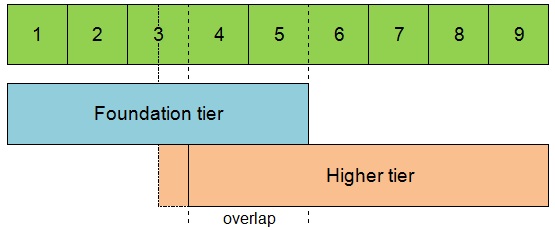New GCSE (9-1) Mathematics tiering and content shifts - Neil Ogden
23 September 2015
When the content required for the new GCSE (9-1) Mathematics qualification was published by the Department for Education it saw the introduction of some completely new content (compared to the preceding GCSE maths), but also a shift of topics that were previously Higher tier only and are now to be part of the Foundation tier assessment too (e.g. trigonometry, standard form).
It’s these topics that are now included as part of the Foundation tier content to that seem to have caused the most debate amongst some teachers, so for a look at why this might have happened, it’s worth going back to consider how the actual tiers have changed in the new qualification...
In the previous GCSE maths, the Foundation tier assessed grades G to C and the Higher tier grades D to A* (although an allowed grade E was awarded on the Higher tier). In new GCSE (9-1) Mathematics, the Foundation tier assesses Grades 1 to 5 and the Higher tier Grades 4 to 9 (with an allowed Grade 3 also to be awarded on the Higher tier).

Ofqual has confirmed how the new grades will compare to the old, with the top grade on the new Foundation tier (Grade 5) being ‘positioned in the top third of the marks for a current Grade C and bottom third of the marks for a current Grade B. This will mean it will be in greater demand than the present grade C’. With the highest grade achievable on the Foundation tier now being of ‘greater demand’ than previously, a consequence of that is that it has brought extra content in with it.
At the Higher tier questions are to be set at Grade 4 and above, meaning that the lowest demand questions here will now be more challenging than previously and we may hence see a reduction in the proportion of learners entered for Higher (the follow-on from this will be in decisions of which tier to enter each learner for and we might now expect to see teachers having to make this decision with learners of a slightly higher ability, those around the Grade 4/5 borderline, rather than the traditional C/D borderline. That’s a conversation for another day, though…).
The way that the tiering has changed hence should be remembered when viewing the changes in content for the new GCSE (9-1) Mathematics, particularly keeping in mind how the Foundation tier is now to cover a wider range of learners than previously.
A key reassurance we can make here is that just because certain topics have now become part of the Foundation tier assessment, that doesn’t mean that Foundation tier questions on these topics will be comparable to those seen on previous specifications on the Higher tier. Questions appearing on the new GCSE (9-1) Mathematics’ Foundation tier targeting these topics will be pitched appropriately at the Foundation tier grades and for a number of topics this means that they’ll quite likely only be appearing in the later questions of the Foundation tier papers, i.e. ‘after the staples’.
For preparation for how these topics might be assessed at the Foundation tier, both the Sample Assessment Materials and Practice Papers available from the ‘Assessment materials’ section of our new GCSE (9-1) Mathematics’ webpage include Foundation tier questions at the correct levels of demand on the topics, with even more papers being planned for Spring 2016. The check-in tests we’ve already released based on our specification’s ‘Initial Learning’ content have been incredibly well received and give further examples of questions on topics at the lowest demands of the Specification. We’re working on the next batch of check-in tests right now (using the content in the second (‘Foundation tier…’) column of our specification and also ones for the Higher tier including content from the third column), to give you even more support in introducing these topics at the right level to all your learners!
If you have any queries or questions on our maths questions, you can comment below, email us via maths@ocr.org.uk, call us on 01223 553998 or Tweet us @OCR_Maths.
Neil
About the author
Neil Ogden - Subject Specialist - Mathematics
 Neil has worked in a variety of qualification lead roles at OCR for a number of years, having joined the Maths team in 2012 and then becoming a Subject Specialist in 2014. Neil led the development of the new GCSE (9-1) maths qualification (J560) and following its accreditation, the majority of his time is currently spent supporting teachers through the introduction of the new qualification.
Neil has worked in a variety of qualification lead roles at OCR for a number of years, having joined the Maths team in 2012 and then becoming a Subject Specialist in 2014. Neil led the development of the new GCSE (9-1) maths qualification (J560) and following its accreditation, the majority of his time is currently spent supporting teachers through the introduction of the new qualification.
Neil is also responsible for the current GCSE maths A and B courses (J562 and J567), as well as the OCR maths Twitter and changes to the maths qualification pages on the OCR website.